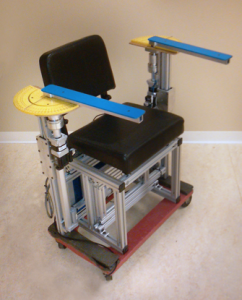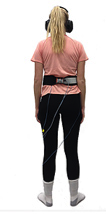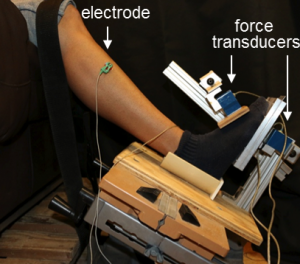Faculty in charge: Bernard Martin, Ph.D.
The SMS-HV Lab investigates asymmetry of sensorimotor systems, tactile proprioception and spatial body representation, enhancement of postural stability by vibrotactile stimulations, muscle fatigue, and human movements. The lab collaborates with other labs and universities, including: D. Adamo (WSU) on Upper limb Asymmetries; K. Sienko (UoM – ME) on Tactile Proprioception and Posture; T. Laeubi (ETH Zurich), B. Steinlieber and R. Seibt (U. Tubingen), F. Violante (U. Bologna), R. Merletti (Polytech. Torino) on Muscle Fatigue; M. Bouri (EPFL) on Lower Limb Asymmetries and Rehabilitation; and H. Beuler and S. Gallo (EPFL) on Tactile Sensitivity and Exoskeleton Stability.
Robotic Arms Chair
 This adjustable chair, equipped with motorized arms, is used to investigate upper limb asymmetries in human position sense, movement sense, and sense of effort. It is currently programmed to analyze sensory and motor deficits in mildly affected stroke patients. Results form healthy individuals and patients are used to develop personalized rehabilitation procedures aiming at improving recovery from stroke.
This adjustable chair, equipped with motorized arms, is used to investigate upper limb asymmetries in human position sense, movement sense, and sense of effort. It is currently programmed to analyze sensory and motor deficits in mildly affected stroke patients. Results form healthy individuals and patients are used to develop personalized rehabilitation procedures aiming at improving recovery from stroke.
Vibrotactile Belt
 Vibrotactile stimulation distributed around the torso at waist level are used to investigate the proprioceptive properties of torso skin receptors and determine the interactions between cognition and sensory information. The stimulations are also used to improve posture control, haptics, or alarm devices based on vibrotactile signals.
Vibrotactile stimulation distributed around the torso at waist level are used to investigate the proprioceptive properties of torso skin receptors and determine the interactions between cognition and sensory information. The stimulations are also used to improve posture control, haptics, or alarm devices based on vibrotactile signals.
Muscle Electrical Stimulation
 Electrical stimulation of muscles is used to induce twitch contractions and measure corresponding changes in force with fatigue. This method is sued to quantify fatigue of long duration resulting from low level repetitive exertions, prolonged standing, or vibration exposure.
Electrical stimulation of muscles is used to induce twitch contractions and measure corresponding changes in force with fatigue. This method is sued to quantify fatigue of long duration resulting from low level repetitive exertions, prolonged standing, or vibration exposure.
